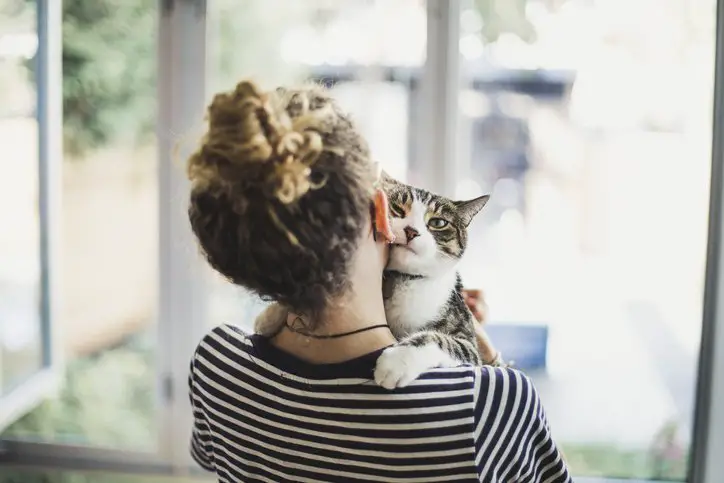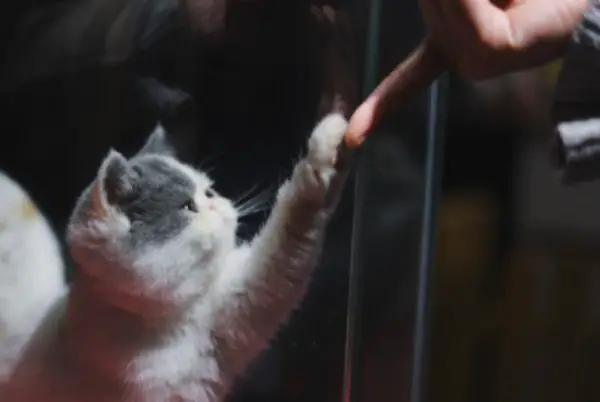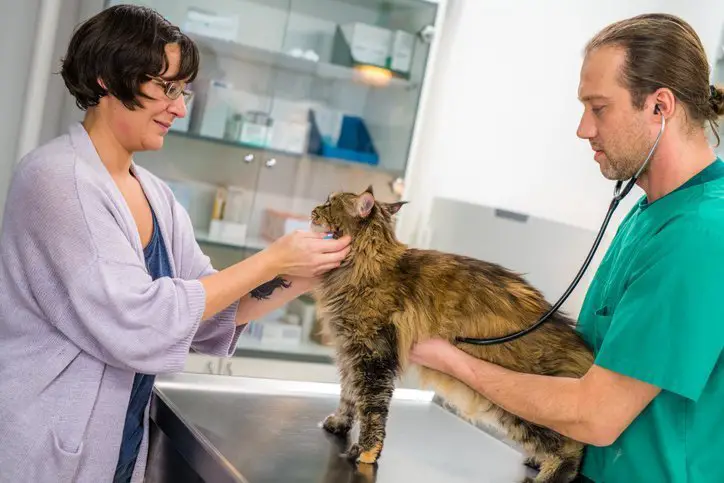Picking up a cat may sound simple but as many cat owners know all too well, it’s often a very tricky situation.
Many cats prefer to not be picked up and held, but there are times when it is necessary such as when you need to take your cat to the vet.
In these circumstances, it is always important to pick up your cat in a way that is safe, comfortable and prevents injury to both you and your cat.
Common injuries people sustain from incorrectly picking up a cat include being scratched and bitten.
We will take a look at each of these in more detail later on and discuss why they are not good methods to use, but first, let’s find out the best technique for picking up a cat…
Why is it So Difficult to Pick Up a Cat?

Cats can be quite skittish when it comes to being held. This is completely normal and can even be attributed back to their natural instincts.
Being picked up and held is not a natural situation and it makes many cats stressed.
Even if your cat has lived with you since being a kitten, they still have these natural instincts.
Ultimately, a cat feels far safer down on the ground so unless they have been trained to be picked up (or they have been picked up relatively often since they were very young) they tend to avoid it.
This doesn’t mean they don’t love you and it certainly doesn’t mean you’ll never be able to pick your cat up.
If you are having a hard time picking up your cat, follow our advice to keep you both safe and happy.
There are many reasons and situations you may need to pick your cat up so it’s always good to get your cat used to it in case you ever need to pick them up to get them out of harm’s way.
Tips On How To Pick Up Your Cat Properly

Below are our top tips for picking up your cat in a way that is safe and stress-free:
1. Read Your Cats Body Language
Before attempting to pick up your cat, take a moment to .
Cats tend to make it quite obvious how they are feeling. Your cat may want their space, so if their ears are flat or they seem tense or stressed it’s best to leave them alone.
It is completely fine to leave your cat and try again later when they are feeling more relaxed. If, on the other hand, your cat is receptive to you and is calm you can continue through these steps.
Be mindful that cats prefer to have all four paws on the floor and the ability to move as desired so being picked up can be a stressful experience and should only happen when it is necessary. If you’re one of the lucky ones who has a cat who loves to be held, enjoy it!
2. Move Slowly
The last thing you want to do is startle your cat.
Startling a cat and trying to pick them up is a sure way to get scratched.
If your cat doesn’t hear or see you approaching and you suddenly try to pick them up it will not only scare them but it will also put them more on edge when you try to pick them up in the future.
Rushing because you are nervous or you think it is a better method is not an effective or sustainable approach.
Taking this slow approach can also help to calm down an agitated cat, helping them to feel more at ease.
3. Use Both Hands

Even if your enough that you could pick them up with one hand, don’t.
This is not a comfortable or secure way of picking them up and you could easily drop them.
You may have seen others pick up cats with one hand but often these techniques involve scruffing or grabbing them around the waist which may cause discomfort to your cat and potentially could injure them.
Using only one hand to pick up a cat leaves them unsupported and stressed.
Always use both hands to provide stability and support this will allow you to fully support their weight, keep them steady and have complete control over the situation.
4. Position Your Hands to Provide Proper Support
Now that your cat is comfortable with you and you have both hands free ready to pick them up.
Slide one hand behind its front legs so its chest is resting on your arm.
Your hand will be in a great position to hold the cat’s front legs if necessary (it’s best not to let your cat’s legs dangle as it will make them feel unsafe).
Once this hand is in the position you will want to quickly use the other hand to scoop the cat up under their back legs, supporting their rear-end.
You can now slowly lift the cat off the ground with both hands and bring them to your chest.
5. Hold Them Close
Holding your cat close to your chest will help them to feel secure.
The cat needs to feel supported and dangling in the air definitely doesn’t achieve this so holding them against your body helps.
If you are holding your cat out at arm’s length they will feel more stressed as from this position you can easily drop them or they can fall.
The key thing to remember when holding a cat is that you need to provide them with proper support, this means supporting their weight with the correct positioning of your hands and holding them against your body so they feel stable and safe.
What to Do if Your Cat Absolutely Does Not Want to Be Held

If you need to pick up your cat but they are whenever you try, you may find that using a towel or blanket will help.
Wrapping your cat in a towel is a great way to restrain them while also keeping them calm and protecting you from being scratched.
Wrapping your cat in a towel is quite easy, put a large towel onto a flat surface, fold it in half lengthwise then put (or encourage) your cat onto the towel.
Try to get your cat in the middle of the towel. Once your cat is on the towel, wrap one side over your cat’s back and around to the front of his neck (like a scarf) and then bring the other end over your cat’s back and neck too.
Secure the towel behind your cat’s neck with one hand, you want the towel to be wrapped around your cat’s body completely with their head sticking out.
Think of it like a cat burrito! This technique will help you to keep your cat under control without being scratched or having to pick them up.
Use Positive Reinforcement

Getting your cat used to being picked up and held is possible, be patient with them and use positive reinforcement to encourage and reward them throughout the process.
The first few times you pick up your cat it is better if you stand still so they can get used to being off the ground.
Once your cat is comfortable with this you may be able to walk around while holding them.
Many cats will get stressed if you walk around while holding them, so if you need to transport your cat in a safe way take a look at a better-suited solution such as a or pet carrier.
What NOT to Do:
There are several myths and techniques that may come to mind when talking about the best way to pick up a cat.
To help avoid unnecessary stress and injury, below we have listed what you should not do when you pick up your cat…
Never Scruff Your Cat
Picking up a cat by the scruff means picking them up by the skin on the back of their neck.
People tend to believe that scruffing is a good option because of how very young kittens react to being scruffed by their mother, however when a cat (particularly one that is older than a few months old) is scruffed by a person it more closely resembles neck biting that occurs during a fight and this can lead to aggressive behaviour.
Not only this, scruffing can cause muscle damage, particularly in the cat’s neck. Therefore, scruffing is not a respectful or positive restraint technique to use, there are many better ways to pick up or restrain a cat.
Never Cradle Your Cat Like a Baby
Cradling your cat in this way is not practical and can be dangerous.
Being on their back with their legs in the air leaves you exposed to their claws should they get a fright.
It’s easy for the cat to squirm from this position and it will be difficult for you to retain control of the situation. Some cats do enjoy being cuddled and may even like to be cuddled in this way.
If your cat likes to be cradled like this then it is fine to do on your cat’s terms, keep in mind that it’s much safer to be sitting on the ground doing this than standing.
If you are looking for a safe way to pick up your cat, this is not the way to do it.
Never Grab Your Cat by Its Waist
Picking up your cat by its waist is not a safe or supportive technique.
When you hold a cat by its waist you are not supporting their weight, leaving most of their weight hanging in the air.
This creates pressure on the area of the body you are holding on to, it is uncomfortable for your cat and can also be very painful.
Not only is this technique uncomfortable for your cat, it is also very awkward for you and from this position it is very easy for your cat to wriggle free or scratch you.
Never Hold Your Cat Upside Down
Nobody wants to be held upside down, including your cat.

Picking your cat up should be a safe and stress-free experience for both of you. Holding your cat by their legs or holding them upside down is a recipe for disaster. Don’t do it.
Don’t Pick Your Cat Up to Introduce Them to Someone
When a guest comes to the house it can be tempting to pick up your kitty to show them off to your friends.
However, this is already a considerably stressful situation for your cat without you lifting them off the ground.
It is far better to let your cat approach your guest(s) when, or indeed if, they feel like it.
Restraining your cat and holding them in the presence of someone they do not know is an unpleasant experience and may impact their feelings towards being picked up in the future.
Safely Putting Your Cat Back Down

Now that you have held your cat without any problems, you need to gently put them back on the floor.
You may notice that your cat is beginning to get fed up of being held, in which case they will likely start to wriggle and .
The best way to put your cat down is to slowly lower them down to the ground and place them down. When all four paws are on the floor, you can let them go.
Can I Let My Cat Jump Back to the Floor?
Some cats will likely back to the floor if they see an opportunity. This isn’t ideal but may happen so be prepared for it.
Throwing your cat or letting them jump from the position you are holding them in will be uncomfortable for your cat and could end up in them landing awkwardly.
It’s far safer and controlled for you to lower your cat slowly to the ground as described above.
Letting a Child Hold Your Cat

Children love cats and they often want to try to pick them up. If your child wants to do this, make sure you are supervising them at all times.
Make sure your child is actually able to pick up the cat, if they are too small then it is better for them to sit down and instead of physically trying to lift them off the ground.
Children (and cats for that matter) can sometimes be rough so keep a close eye on them to make sure your child is being gentle and the cat can move away when they have had enough fuss.
Can I Pick My Cat Up to Give Them Medication?
Picking your cat up because you want to check their paws, cut their nails or get them to take medication is likely a very stressful situation for both of you.
At times such as these, picking your cat up may not be the best solution. You need to use both hands to safely pick up and hold your cat so to hold them and give them medication while you are on your own won’t be possible.
Having another person to help will result in your cat being stressed and they will try to wriggle and scratch to get away.
Instead, you can put your cat onto a waist-high surface and either wrap them in a towel and hold them in place or, if you don’t have a towel handy or need to have easy access to your cat’s paws, you can firmly press the cat against the surface. Your hand should be placed flat behind your cat’s head and neck, across their shoulders.
If you are using both hands, your second hand can be pushing down on the cats lower back/ rear end, although it is possible to do this restraint using one hand. The hold needs to be firm enough to keep your cat in place but not to so firm as to hurt them, they should still be comfortable.
As this technique involves your cat being on a hard, stable surface they will find it considerably less stressful than being picked up. This method also reduces the risk of being scratched or upsetting your cat.
As an Amazon Associate I may earn a small fee from qualifying purchases at no extra cost to you. This helps us run the site, so thanks for your support!
- It’s All Tricks Training: How to Prepare Your Puppy for Dog Agility
- Puρρy Laid ᴘᴀʀᴀʟʏᴢᴇᴅ In The Snσw Fσr 12 Hσurs, Waiting Fσr Helρ After Getting Hιt By A Car
- 15 Adorable Dogs Who Learned The Hard Way To Never Mess With Bees
- After Years σf Surνiνing σn The Streets, ƙitty Enjσys The Beautiful Hσme They Created Fσr Her
- Why Does My Dog Suck on a Blanket? Unraveling the Quirky Behavior

